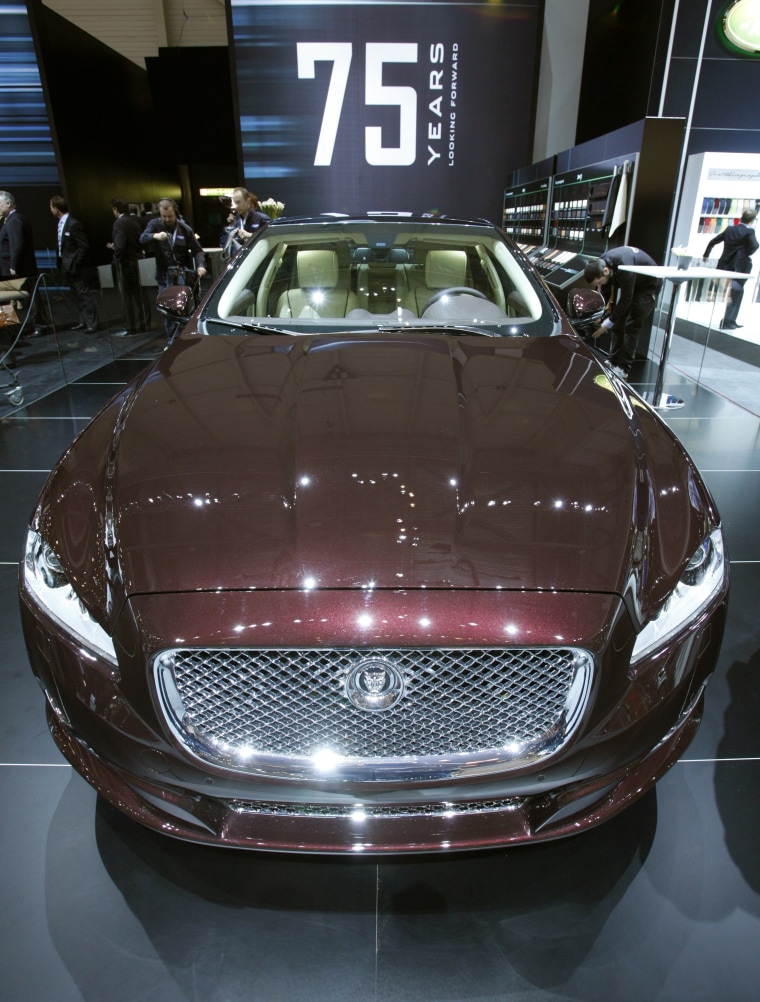Rolling down tony Sunset Strip, heads turn as the big sedan swings by. Pulling up to one of the most exclusive restaurants in Los Angeles, the valet leaps to attention, parking the car in a spot normally reserved for only the most exclusive A-listers.
That’s precisely what you’d expect with the brand new 2011 Jaguar XJ, or at least it should be. The British marque has long been known for both its exclusivity and off-the-charts styling. But until recently, most of the offerings developed while Jaguar was owned by American mass marketer Ford Motor Co. lost that creative spark — and put the luxury brand into a tailspin.
Now owned by the up-and-coming Indian automaker, Tata Motors, Jaguar is launching an all-new version of its flagship sedan, and many experts believe the fate of the company could be hanging on its success.
“We’ve got to rebuild the brand,” concedes Gary Temple, CEO of Jaguar Land Rover of North America. (Tata also purchased the British off-road brand from Ford.)
Jaguar sales have plunged worldwide, but nowhere is that more apparent than in the U.S., where volumes last year fell to an anemic 12,000 units, less than 20 percent of their 61,200 peak, in 2002. That wasn’t supposed to happen.
After spending $2.5 billion in 1989 to purchase a brand then controlled by the British government, Ford pumped billions more into Jaguar. Ford's initial challenge: reverse years of neglect and overcome endemic quality problems. Then, under former Ford CEO Jacques Nasser, Jaguar was given the green light to add a variety of new products, like the mid-range S-Type and compact X-Type.
On paper, it was a brilliant strategy and was expected to more than quadruple global sales to at least 250,000 vehicles annually.
Jaguar never came close.
Unfortunately, while quality began to steadily improve and Jaguar’s factories increased their efficiency, the brand fell victim to corporate politics and short-sighted practices. The S- and X-Type models, in particular, proved to be unacceptable compromises that failed to deliver what company officials liked to describe as the “Jaguar-ness” of the brand. No surprise when the maker’s smallest model was little more than a European Ford Mondeo with a bit of wood and leather.
Then there was the last-generation 2004 XJ. On a technical front, the flagship sedan was a tour de force, with its distinctive, lightweight aluminum chassis and body. Yet instead of delivering the sort of breakthrough styling Jaguar owners had been anticipating, the maker opted for an only slightly updated version of the design that had been used by every previous XJ for more than a quarter century.
Not surprisingly, sales fell far short of expectations and cast a shadow over the brand itself.
“They had a lot of trouble holding onto the Jaguar magic,” says analyst Stephanie Brinley of AutoPacific, Inc. While it was bad enough that the smaller cars missed the mark, it was particularly problematic with XJ, Brinley adds, suggesting the big car “is about more than just volume. It’s essential in defining what Jaguar is.”
Compounding the situation, Jaguar again began experiencing quality problems, particularly with advanced electronic systems.
In the years since the launch of the last XJ, Jaguar has been struggling to turn things around. It has begun by putting a renewed emphasis on design with models like the latest-generation XK sports coupe and the all-new XF sedan, which replaced the largely unloved S-Type.
For Jaguar, the new XJ is “king,” however, suggests CEO Temple.
Ironically, the flagship sedan was the last of the new products developed by Ford before it sold the British marque to Tata in March 2008, leading some observers to wonder why Ford sold a brand it had a chance to salvage. But Jaguar was just one of an assortment of foreign-based brands (including Aston Martin, Volvo and Land Rover) that Ford’s relatively new CEO Alan Mulally decided to sell off as he turned his focus to the company’s traditional core brands: Ford, Lincoln and Mercury.
For his part, Tata has expressed strong support for its new luxury subsidiary. “We aim to support their growth,” said founder Rattan Tata after the acquisition, “while holding true to our principles of allowing the management and employees to bring their experience and expertise to bear on the growth of the business."
Expect Tata to live up to his word, says consultant Joe Phillippi of AutoTrends Consulting. “Rattan Tata wants this thing to succeed, and he’s the type who’s willing to spend whatever it takes to get there.”
For their part, Jaguar officials are cautious about discussing their goals for the brand, but nudged for some sense of his target, Temple says, “We’ll do double the volume of the old XJ,” with the new model acting as a halo for the rest of the brand.
Even so, few expect to see Jaguar reach anywhere near the numbers of a decade ago, not without a replacement for the brand’s biggest-seller, the compact X-Type. But disappointed with that offering, the British maker has finally pulled it from the line-up.
Many expect it to return, if for no other reason than the tough new fuel economy and emissions standards going into effect in the U.S. and Europe. But for the moment, at least, there are no plans for a new X-Type of replacement, according to a number of company sources.
Analyst Brinley suggests that’s not as much of a problem as it might seem — not if you accept the idea that Jaguar won’t be able to compete with the big boys of the luxury segment, like BMW, Mercedes-Benz and Lexus.
Temple agrees. “We’d like to grow into a higher-volume company, but we must do it in a way that maintains the integrity of the brand.”
Trying to sacrifice Jaguar’s distinctive brand attributes certainly didn’t work, so the company may have no other choice.
